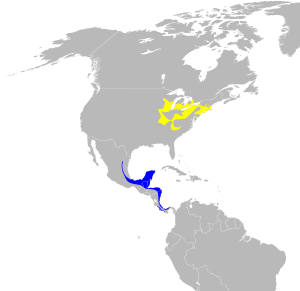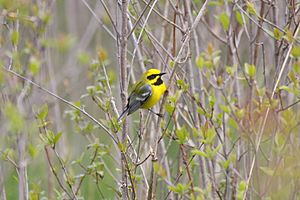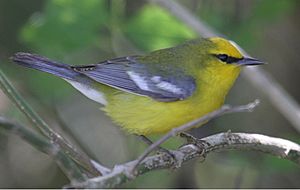Blue-winged warbler facts for kids
Quick facts for kids Blue-winged warbler |
|
|---|---|
 |
|
| Adult male in Maine, United States | |
| Conservation status | |
| Scientific classification | |
| Genus: |
Vermivora
|
| Species: |
cyanoptera
|
 |
|
| Range of V. cyanoptera
Breeding range Winter range |
|
| Synonyms | |
|
|
The blue-winged warbler (Vermivora cyanoptera) is a small, colorful bird. It's a type of New World warbler. These birds are about 11.5 cm (4.5 in) long, which is about the length of a pen. They weigh around 8.5 g (0.30 oz), which is lighter than a pencil.
Blue-winged warblers live and breed in eastern North America. You can find them in places like southern Ontario and the eastern United States. Their home range is slowly growing northwards. They are replacing a very similar bird, the golden-winged warbler.
The name "blue-winged warbler" comes from its bluish-gray wings. These wings stand out against the male's bright yellow body. The scientific name for their group, Vermivora, means "worm-eating." This group used to include many warblers. Now, it only includes the golden-winged warbler and the Bachman's warbler, which is thought to be extinct.
The famous scientist Carl Linnaeus first described the blue-winged warbler. This was in his book Systema Naturae in the 1700s. Its scientific name has changed a few times since then. In 2010, the American Ornithologists' Union changed its name to cyanoptera. This corrected an old mistake in its original naming.
Contents
Blue-winged Warbler Hybrids
Blue-winged and golden-winged warblers are often compared. They are very closely related. Long ago, blue-winged warblers lived more to the west. Golden-winged warblers lived closer to the Atlantic coast. But over time, their homes changed. Things like cities growing and forests being cut down made a difference.
Golden-winged warblers are often pushed out by blue-winged warblers. For example, in Central New York, blue-winged warblers grew in number in the 1980s. At the same time, golden-winged warblers decreased. This made people think blue-winged warblers caused the golden-winged ones to disappear.
However, studies show they are like "sister species." They split apart about 1.5 million years ago. They are 99.97% alike genetically. Their main differences are how they look and their songs.
New studies also show that these two warblers can live together. They can also breed with each other where their homes overlap. When they do, they create two types of hybrid birds. These are called Lawrence's warbler and Brewster's warbler.
These special hybrid birds are found where the two species meet. This is often in the Great Lakes and New England areas.
Brewster's Warbler
The Brewster's warbler is more common. It is also genetically dominant. It looks gray on top and whitish underneath. Males are whitish, and females are yellow. It has a black stripe through its eye. It also has two white bars on its wings.
Lawrence's Warbler
The Lawrence's warbler is rarer. It is genetically recessive. The male is green and yellow on top and yellow underneath. It has white wing bars. Its face pattern is like the male golden-winged warbler. The female is gray on top and whitish underneath. It has two yellow wing bars. Its face pattern is like the female golden-winged warbler.
How Hybrids Differ
Song Patterns
The four types of birds (blue-winged, golden-winged, Brewster's, Lawrence's) have different main songs. Their first type of song, called Song I, can be hard to tell apart. But their second type of song, Song II, is easier to distinguish.
Physical Appearance
Brewster's warblers often look like golden-winged warblers in their feather colors. But they have a blue-winged face pattern. They also have different amounts of yellow. Lawrence's warblers look like blue-winged warblers in their feather colors. But their wing pattern is similar to the golden-winged warbler.
Blue-winged Warbler Description
The blue-winged warbler is a small bird. It is about 11.4–12.7 cm (4.5–5.0 in) long. Its wingspan is about 17–19.5 cm (6.7–7.7 in).
Male Blue-winged Warbler
Breeding males have a bright yellow head, chest, and belly. They have no stripes on their belly. They have a thin black line through their eyes. Their wings are light bluish-gray with two white bars. These white wing-bars are easy to spot. Males often look like their heads are pointy.
Female Blue-winged Warbler
Females are not as bright as males. They have less yellow on their head. Their eye line is less noticeable. It looks more gray and light, not black.
Young Blue-winged Warblers
Young blue-winged warblers are smaller than adults. They are olive green. Their wings are similar to adult wings. They have a pinkish beak. Their wing bars are almost invisible.
Blue-winged Warbler Sounds
The blue-winged warbler's song is a series of buzzing notes. It sounds like "bee-buzz." Their call is a sharp "chip."
Where Blue-winged Warblers Live
Blue-winged warblers are migratory birds. This means they travel long distances. They spend winter in southern Central America. They breed in North America. Their breeding range goes from Nebraska in the west to southern Minnesota, Wisconsin, Michigan, and southern Ontario in the north. It extends to central New York, southern Vermont, southern New Hampshire, and New England in the east. To the south, it reaches western South Carolina, northern Georgia, northern Alabama, eastern Tennessee, and southern Missouri. Sometimes, one might fly far off course to western Europe, like to Ireland.
They like to live in open, scrubby areas. You can find them in old fields with shrubs and trees. These areas are often next to tall deciduous trees. They prefer places with higher ground. They also like areas with a lot of grass and tree cover.
Blue-winged Warbler Ecology
Blue-winged Warbler Diet
Blue-winged warblers mostly eat insects and spiders. They find insects on plants like apple trees, walnut trees, and water hemlock. Adult birds sometimes hang upside down to pick insects off leaves. They also gather insect larvae for their young. Some larvae they feed their babies include types of aphids and lace bugs. What they eat can change with the seasons and where they live. It also depends on what food is available. They are not picky eaters.
Blue-winged Warbler Reproduction
Blue-winged warblers build their nests on the ground or low in a bush. Their nest is shaped like a cup. Females lay four to seven eggs. The female bird sits on the eggs for 10 to 11 days to keep them warm. The baby birds are born helpless. They leave the nest after 8 to 10 days.
Blue-winged warblers use songs to talk to each other. They have different songs for fighting, nesting, and finding a mate. During breeding season, males arrive first at the nesting site. They wait for a female. Females usually arrive about a week after the males. While waiting, males sing all the time. Once a female arrives, the singing slows down. The tune might change until they find a partner. After they mate, their songs become much shorter.
See also
 In Spanish: Chipe aliazul para niños
In Spanish: Chipe aliazul para niños




